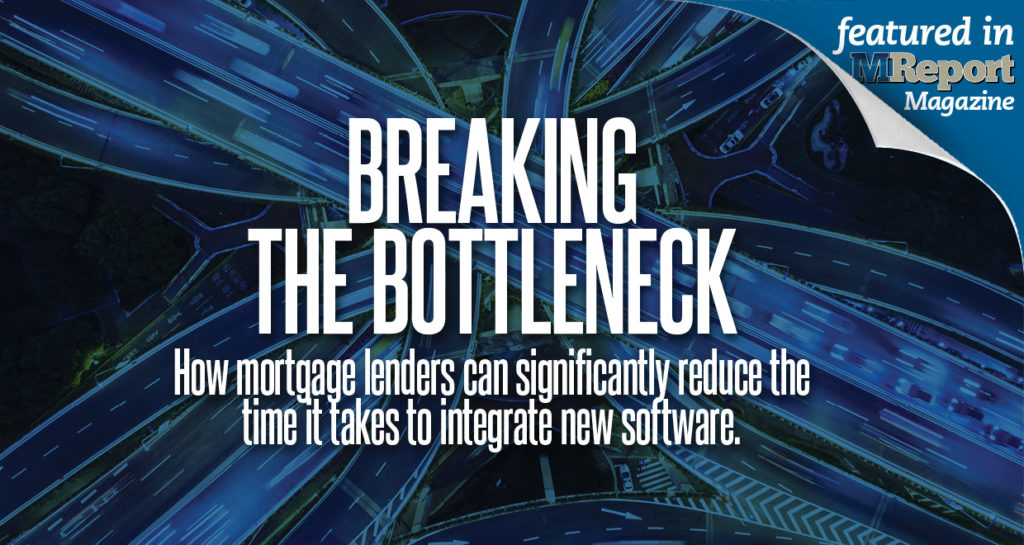
Editor's note: This feature originally appeared in the June issue of MReport.
In my years working with mortgage bankers, one thing that has truly impressed me is how the mortgage industry embraces technology. The competitive nature of the industry is driving this rapid adoption of new tech tools, which in turn is narrowing the time allowed for implementations. Management cannot wait several months or a year for the benefits offered by the desired technology.
Best practices such as devising a formal implementation plan, getting C-level support, securing proper resources, and reviewing the process afterward to help develop best practices are now widely accepted within the lending community. Many lenders still suffer through long implementation timelines, mainly because of bottlenecks that hold them back and slow down the process. Identifying the most common bottlenecks and some of the options for getting around them can significantly speed up the implementation process.
The process of identifying these bottlenecks and how each vendor deals with them must take place as part of the selection process. The bottlenecks are often typical for a given technology, and the vendor has either addressed them or not. Take accounting solutions for example. In every accounting system, you must define a chart of accounts listing the financial categories for each transaction. Historically, you could not change the chart of accounts after entering the transactions. This led many users to believe they had to define the perfect chart before beginning the implementation. Waiting for the chart of accounts to be completed can bring implementation to a grinding halt. This was a simple bottleneck to address by providing the capability to allow the client the ability to modify the chart at any time. In so doing, the mortgage lender doesn’t have to feel like they have to create a perfect chart that will last 20 years.
Discerning the Data
One common bottleneck occurs around not just entering the initial data into the system but understanding the number of integrations required going forward to import data into the system or to send data out. Thankfully, the days when this information had to be hand entered are long gone. Data is very accessible today. There are various technologies available such as exchange transformation load (ETL), an application-programming interface (API), or more traditional importing of data using comma-separated value (CSV) files.
The use of APIs is popular and necessary with cloud-based products but implementing such technology does require a certain level of technical expertise from IT staff. The same can be said for ETL. Depending on IT staff to transfer data using these technologies can slow down implementation. The use of these solutions should be encouraged but the integration of such technologies may take time and you must address them early in the process. The time needed to implement and maintain these technologies may not be appropriate for all data transfers. Many lenders deal with a large number of appraisers and other vendors that will not send their invoice by using an API interface. For these companies, it’s easier for the vendor to provide the loan level detail in a CSV file. Staff personnel are usually very familiar with spreadsheets and have no problem working with the CSV files. The result is that more information gets imported to the system rather than hand entered, allowing management to more quickly see the benefits of the new system.
Customizing the Solution
Another common bottleneck is the need for custom programming. When a lender purchases advanced technology, there may be specific development requirements that help justify the cost of the technology.
This bottleneck is one that you can solve in the selection phase of the technology purchase. Historically, in the case of accounting systems, much of the custom programming centers on reporting. Access to data and reporting, in general, is the goal of the purchase and there is typically an understanding of the types of reporting needed.
Many technology solutions, such as generic accounting software, require tremendous amounts of custom development to meet a client’s reporting needs. This level of development can not only delay the implementation project but represent the largest component of the cost.
A simple way to avoid these delays and cost is for the lender to discuss with the vendor what reporting options are currently available that may have already been developed for other lenders. When it comes to customizations, there is no need to reinvent the wheel. It is very likely that no matter how unusual a lender’s reporting requirements may seem, an organization with years of implementation experience will be able to offer viable options.
Lenders are getting better about conducting technology implementations, but they are still putting up with projects that take far too long. By identifying the bottlenecks early in the process, lenders can start benefiting from their chosen technology sooner.

 theMReport.com Your trusted source for mortgage banking news
theMReport.com Your trusted source for mortgage banking news









